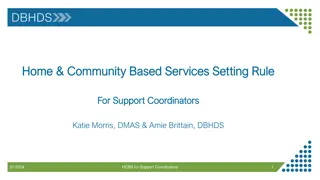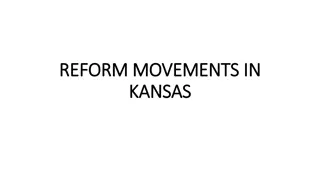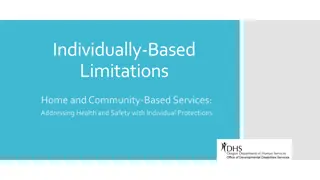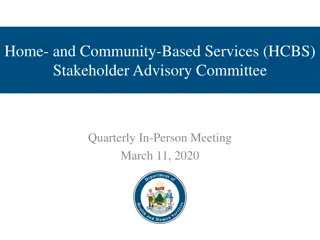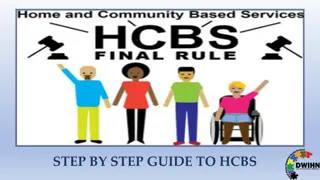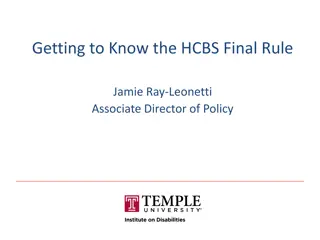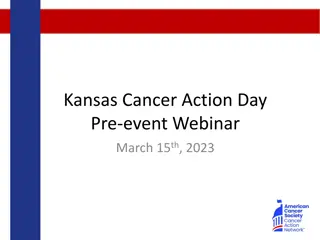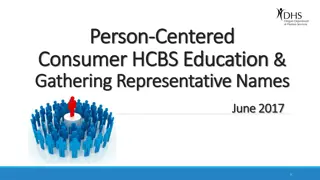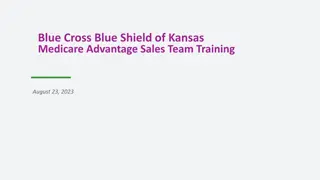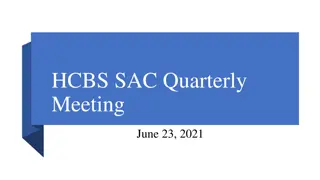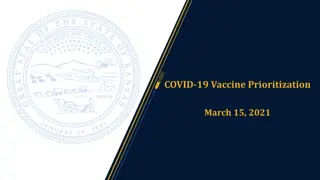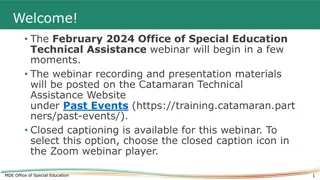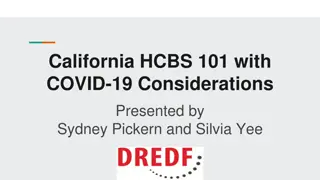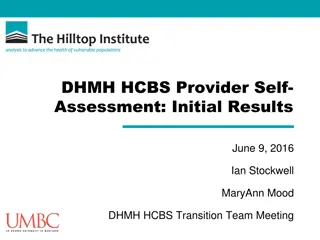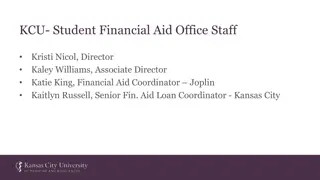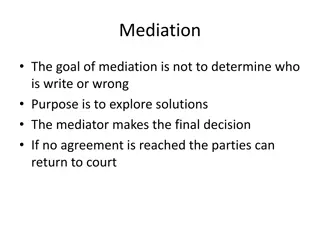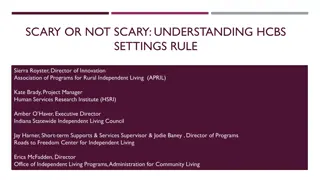Understanding HCBS Waivers in Kansas
HCBS waivers in Kansas provide authorization from Medicaid for beneficiaries to receive treatment at home or in a community setting instead of entering an institution. These waivers must meet specific requirements and cover a range of populations and services, including I/DD, Autism, Technology Assistance, SED, Physical Disability, Brain Injury, and Frail and Elderly. Access points are available for system contacts for DD services and SED services.
Download Presentation

Please find below an Image/Link to download the presentation.
The content on the website is provided AS IS for your information and personal use only. It may not be sold, licensed, or shared on other websites without obtaining consent from the author. Download presentation by click this link. If you encounter any issues during the download, it is possible that the publisher has removed the file from their server.
E N D
Presentation Transcript
IDD Waiver and Foster Care Michele Heydon M.A. KDADS HCBS Director August 28,2020
HCBS waiver A Home and Community Based Services (HCBS) waiver is an authorization from Medicaid that allows a beneficiary to receive treatment at home or in a community setting, rather than being required to enter an institution. The HCBS waiver program was initiated in the 1980s. Individual states administer their own waiver programs and have specific information on how to apply for their programs. Social workers and counselors can assist people with the process. Historically, Medicaid only provided funding to institutions like nursing homes. People eligible for Medicaid who needed skilled nursing services, personal care, and related services were forced to enter institutions in order to access benefits.
HCBS Waivers Requirements State HCBS Waiver programs must: Demonstrate that providing waiver services won t cost more than providing these services in an institution Ensure the protection of people s health and welfare Provide adequate and reasonable provider standards to meet the needs of the target population Ensure that services follow an individualized and person-centered service plan
Kansas HCBS Waivers Waivers are an agreement with CMS of what services and how we provide services to different populations. These waiver applications cover everything from assessment, level of care (who, what, where and how) To services, what services, duration amount and scope. To ensuring health and welfare, program evaluation, appeal rights etc.,
Kansas HCBS Waivers Kansas has seven 1915(c) waiver programs I/DD Waiver serves ages 5 and up This waiver has an over 8 year waiting list Autism Waiver serves ages 0 to 5. This waiver has an extensive proposed recipient list Technology Assistance Waiver serves 0 to 22. SED Waiver serves children 4 to 18 Physical Disability Waiver serves ages 16-64 This waiver has a waiting list
Kansas HCBS Waivers Continued Brain Injury Waiver serves ages 0-64 Frail and Elderly Waiver serves ages 65 and up
Access Points: Access points for system contacts: DD services: the local CDDO SED services: the local CMHC TA services: Children s Resource Connection 316- 721-1945 Autism services: https://kdads.ks.gov/commissions/home- community-based-services- (hcbs)/programs/autism
Access Points Continued FE/PD/BI services: Aging and Disability Resource Centers (ADRCS)
IDD: working with the Targeted Case Manager, MCO Care Coordinator, CDDO, and CPA Targeted case management services are those which assist the beneficiary in gaining access to medical, social, educational, and other needed services. The DD Case Manager provides: Assessments to determine service needs (but not the functional assessment related to eligibility); Development of a specific support/care plan; Referral and related activities; Monitoring and follow-up activities.
CDDO Role Offers local choice of services (regulatory role) Quality assures service provision by local pro- viders Tracks waiver and waitlist children and adults Ensures that services are provided according to person-centered support plan Ensures health, safety, welfare of people within catchment area.
Starting the Person Centered Service Plan with the TCM and Care Coordinator Assess the person s needs Determine the level of strength of the person s natural supports Determine what level of system supports will be required to meet the person s needs Determine which systems can provide supports
Benefit of Person-Centered Service Planning The child s plan for support is stronger when there is reliance on providers from multiple systems; not just one provider or one funding source.
Strategies of the Care Coordinator Determine what service or support is needed Know the eligibility criteria for the service and the process to be determined eligible Identify the funding source of the identified service and the provider for that funding Decide what amount of support is minimally required Implement a Person Centered Service Plan.
When to Notify Your MCO Care Coordinator Changes in the health of the person Changes in the behaviors of the person Changes in the health of the parent/guardian Educational transitions Need for a Waiver transition Changes in Medicaid status Involvement with Child/Adult Protective Services Involvement with Law Enforcement Involvement with the legal system
Educational Transitions Age 3: exit from Part C, Infant/Toddler Services Age 5: entrance into kindergarten (full-day) Grade 6: entrance into middle school Grade 9/10: entrance into high school Age 14 for Vocational Rehabilitation referral. Grade 12: graduation from high school Age 18-21: continued education at high school or specialty school By Age 22: exit from public education
Changes in Medicaid Status Changes in household income Family members wages, child support, etc. Person s wages from employment Entering/exiting foster care Turning 18 years old Receiving an inheritance Receiving SSI Receiving Survivor s Benefits
DD Service Options Use of the Service Access (Waiting) List Use of Crisis Funding Use of Voluntary Placements for children and youth under 22 years Use of other service systems: social services; medical care; beneficiary programs
IDD Waitlist and Foster Care Waitlist is currently over 8 years long Person is not re-assessed once on the waitlist until the person is offered funding by KDADS Can be by-passed by foster children for non-supervisory, disability-related support needs, or Can be by-passed in crisis situations in order to avoid a child coming into custody (requires DCF/court documentation) Can be by-passed in order for a child exiting custody to have identified disability support needs met. Foster Care Exception requests go to the CDDO first, then to KDADS IDD Program Manager for review and determination.
IDD Crisis-Exception Requests Requests are first made through the CDDO area in which the person lives (placement area) Crisis requests based on APS/CPS, Law Enforcement, documented Abuse, Neglect, Exploitation (ANE), and/or Significant, imminent risk to self, others Community supports must first be exhausted before making a request (documentation required) Cannot duplicate services already available, or services that should be provided by the foster parent. CDDO approved requests then go to KDADS IDD Program Manager for review and determination
Self-Directed supports vs. agency- directed supports (in-home) Children in custody must have agency-directed in- home supports. In areas where no agency-directed supports are available for foster children, an exception for self- directed supports must go to KDADS IDD Program Manager for review and determination. Children in Children s Residential setting cannot also access in-home supports, as that constitutes a duplication of services
DD Waiver and Foster Care IDD Waiver supports cannot be supervisory in nature for children in custody Licensed Foster Care placements cannot have more than two children in the home unrelated to the IDD waiver participant in order for the child s waiver to continue. Any overpopulation request must happen prior to the home becoming overpopulated All overpopulation requests related to a child s waiver go to KDADS IDD Program Manager for review and determination. Overpopulation requests start between CPA and DCF Licensing. Once DCF Licensing reviews, then goes to MCO. MCO makes request to IDD Program Manager.
Private Pay contracts for IDD adult services 18+ person in FC: private pay contract between CPA and IDD provider Provider dependent on payment via private pay contract Prior to ROC, exception access request needs to be initiated. TCM, MCO, DCF, CPA, CDDO, and KDADS all need to be involved. Pre-planning for ROC needs to happen, and all parties need to be on the same page.
Childrens Residential: Licensed Foster Care setting for voluntary placement Can only have two children in the home not related to the IDD waiver participant. Starts at age 5, ends at the latest, by the 22nd birthday Must be located in or near the child s home community (home county) Any exception requests must go to KDADS IDD Program Manager for review and determination. Cannot be used as a way to ROC a foster child.




